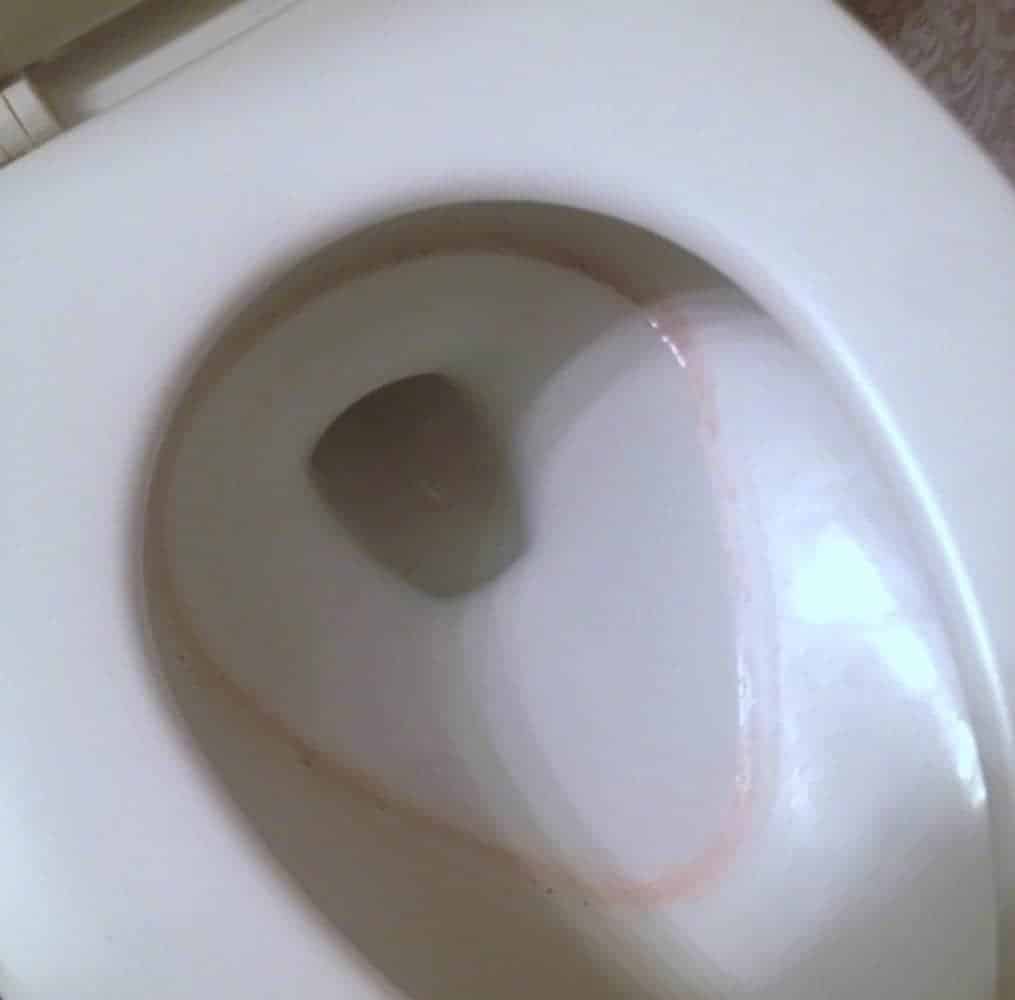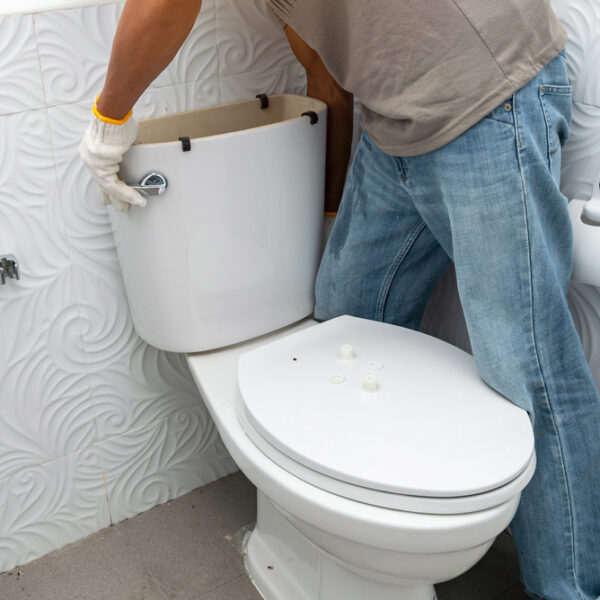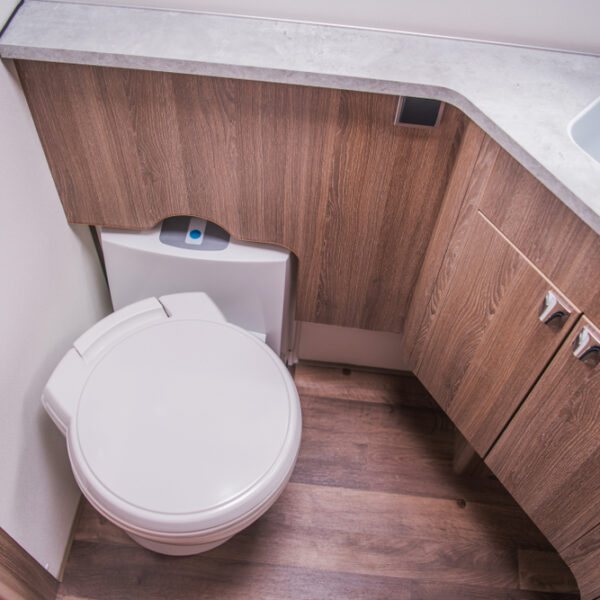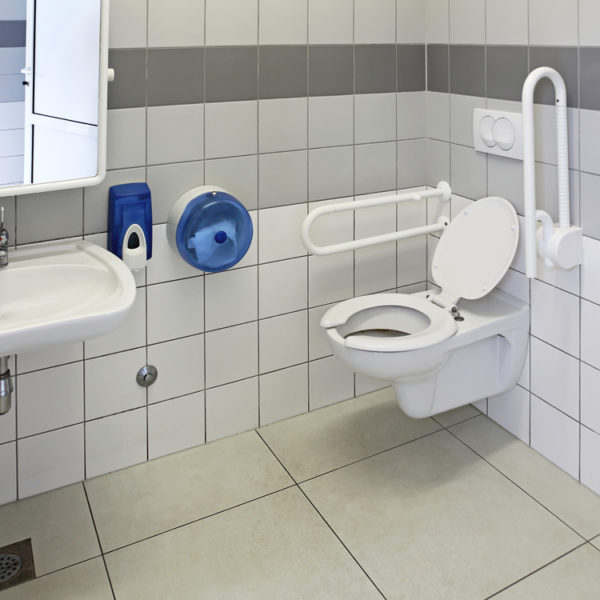When they develop, pink stains in toilet bowls are an eyesore, and they can also be embarrassing when a guest needs to use the bathroom. Unfortunately, however, they are a common problem, and sometimes it seems like nothing can stop them.
The good news is they’re not too difficult to clean off or prevent from appearing in the first place if you know how to do it – so in this post, we’ll give you all the info you need as we discuss the nasty problem of pink ring stains in toilet bowls.
What Causes Pink Ring Stains in Toilet Bowls?
If you want to know how to get rid of pink toilet rings – as well as how to prevent them from returning – it helps to know how they get there in the first place. So what causes pink toilet rings?
The good news is that it’s probably not a problem with your water supply – there’s nothing in your water causing the stains in your toilet or elsewhere.
In most cases, these unsightly marks are caused by bacteria, and the culprit is almost certainly Serratia marcescens, an airborne strain of bacteria that thrives on moisture, dust or phosphates – and needs little else to survive and grow.
The tell-tale signs of Serratia marcescens in your home are pink, pink-orange or gray marks appearing on walls, shower curtains, shower heads, tiles, grout or toilet bowls – and in toilets, they usually create a pinkish ring around the water line.
Since this type of airborne bacteria is carried in the wind, having good ventilation actually helps it float into your bathroom and make its home on your walls or wherever it finds moist surfaces.
Indeed, some people report pink stains only happen during the summer months when doors and windows tend to be left open.
It’s not an especially harmful type of bacteria. It’s found in the soil, in food and on animals, and if it starts growing on a pet’s food bowl, the animal is unlikely to get ill.
However, most people will be unhappy about having these unpleasant marks in their home and will be keen to clean them off – which is something we’ll come to in just a moment.
But first, let’s think about other things that can cause similar stains.
Is there anything else that can cause pink ring stains on toilet bowls?
Another possibility is that the stains are being caused by iron in your water supply, which may happen if you have old pipes or if the water comes from a well.
However, this would cause pink ring stains in all of your toilet bowls at the same time and not just one, so if you only find this kind of pink ring in one toilet, you can almost rule out this possibility.
However, if you still suspect rust or iron in the water could be the reason for the stains, you should consider calling out a plumber to check your pipes.
This is because if your pipes are corroding out of sight, they may eventually burst, and if this happens, it can cause lots of expensive damage.
Sometimes, hard water deposits can also cause similar colored stains. When the water in your home carries minerals like calcium or magnesium, it can leave toilet rings, and these can sometimes look similar to Serratia bacteria stains.
You may be able to tell the stains apart since bacteria leaves a scummy film while hard water leaves a prominent deposit.
However, although the cause may be different, most of the same methods can be used to remove mineral deposits too, so in a way, it doesn’t matter.
What can you use to remove pink ring stains from Toilet Bowls?
So now let’s think about the kind of thing you can use to clean pink stains from toilet bowls – and elsewhere in your bathroom.
Of course, you can use a regular store-bought toilet bowl cleaner or other detergent intended for cleaning bathrooms. However, you may not want to use harsh chemicals, or you might just not have any to hand – in which case, some of the following can be used instead.
Vinegar
Vinegar is an incredibly useful and effective cleaning agent thanks to the acetic acid it contains. This is why you can use it for all manner of household cleaning jobs – including removing pink ring stains from toilet bowls.
It’s best to buy cleaning-grade white vinegar since it’s cheap and easy to find. However, if you don’t have access to any when you need it, you can also use food-grade vinegar, which works just as well.
Bicarbonate of soda
Bicarbonate of soda, also known as baking soda, is another incredibly useful product to have at home since it can be used for all kinds of cleaning jobs. As with vinegar, use cleaning grade baking soda rather than the food-grade version.
Lemon juice and essential oil
Lemon juice contains citric acid, which makes it a useful cleaning solution, just like vinegar. However, it smells better than the pungent odor of vinegar, so many people find it preferable. Mixing it with essential oil will make it more effective and even better smelling.
Borax
Borax is a bit like bicarbonate of soda, but it’s harsher and more potent, so you’ll need to buy it in a specialist hardware store since supermarkets generally don’t carry it.
Coca-Cola
Coke might be one of your favorite sodas, but it also has powerful cleaning properties thanks to its acid content as well as the carbonation that causes it to fizz. If you don’t want to pour genuine Coca-Cola down the drain, cheaper generic colas will do the same job.
Bleach
If you don’t want to mess about with gentle home remedies, you might prefer to just reach for the bleach instead.
A cup of chlorine bleach will certainly take care of your bacteria problem, but it’s not particularly good for the environment, and it can be harmful to your skin and especially your eyes, so most people prefer to turn to it only as a last resort.
How to get rid of pink ring stains from Toilet Bowls
Now let’s have a look at a couple of methods you can use for cleaning the pink ring stains from your toilet.
How to get rid of pink ring stains from Toilet Bowls with Vinegar
What you’ll need:
- Vinegar
- Spray dispenser
- Old cup or ladle
- Old towel
- Toilet brush
Step 1. Empty the water from the toilet bowl
Before you start cleaning, you’ll need to remove the water from the toilet bowl. To do this, simply scoop it out with an old cup and then use an old towel to mop up whatever’s left in the bottom.
Step 2. Put a cup of vinegar into the spray dispenser
Pour a cup of vinegar into the spray dispenser to make it easy to spray onto the toilet bowl.
Step 3. Spray on the vinegar and leave it to act
Spray the vinegar generously all over the pink discoloration in the toilet bowl and leave it for at least half an hour – or longer if possible – for it to act on the bacteria.
Step 4. Scrub with the toilet brush and flush
After the vinegar has been left to act on the stain, scrub it off vigorously with the toilet brush. Once that’s done, simply flush the toilet twice to wash away the waste and refill the bowl.
Step 5. Inspect and repeat as necessary
Inspect the toilet to see if the stain has gone. If there is still some discoloration, simply repeat the steps once or twice more until the stains disappear.
How to get rid of pink ring stains from Toilet Bowls with Bicarbonate of soda
What you’ll need:
- Bicarbonate of soda
- Water
- Cup
- Spatula or old spoon
- Towel
- Old cup or ladle
- Toilet brush
Step 1. Empty toilet bowl
Empty the toilet bowl as explained above in Method 1.
Step 2. Mix up a paste of bicarbonate of soda
In a cup, mix up a paste of bicarbonate of soda with a ratio of 2:1 bicarbonate of soda to water.
Step 3. Apply the paste to the affected area
Using a spatula or an old spoon, apply the paste to the area affected by the stain.
Step 4. Leave the paste to act
Leave the paste in place for at least half an hour or longer to give it time to work on the stain.
Step 5. Scrub off with the toilet brush and flush
Scrub the affected area with the toilet brush – then flush twice to wash away the baking soda paste and refill the toilet bowl.
Step 6. Inspect and repeat as necessary
Check to see if the stain has gone – and if not, simply repeat a couple of times until it disappears.
Other ideas for cleaning pink stains from toilet bowls
Lemon and essential oil
Simply follow the steps in Method 1 above but substitute lemon juice mixed with a few drops of essential oil for the vinegar.
Vinegar and baking soda
Use Method 2 above, but instead of using water, mix the paste up using vinegar instead. Stick to the same ratio of 2:1 bicarbonate of soda to vinegar.
Borax
With borax, you can either sprinkle some onto the stain or mix up a paste as described for baking soda. For an extra-potent mix, use borax with vinegar instead of water. Stick to the same 2:1 ratio.
Bleach
Mix up a solution of bleach and water and use it to scrub with a toilet brush or wipe clean with a cloth. It’s best to wear rubber gloves, a mask and eye protection whenever working with bleach. Read the instructions on the bottle or packet carefully before use.
How can you prevent pink stains from appearing?
Since prevention is always better than a cure, you’ll want to do what you can to prevent pink stains from appearing in the first place rather than waiting for them to develop before trying to tackle them. Here are some ideas for how to do it.
Keep toilets clean
The most effective way to keep pink stains from appearing is to make sure your toilets are kept clean. Regular maintenance is key, and cleaning your toilets properly once a week will play a big role in keeping them free of stains caused by invading bacteria.
Keep bathrooms as dry as possible
Since Serratia marcescens loves moist locations, do what you can to avoid dampness in your bathroom. This obviously won’t be possible in your toilet bowl, but if you keep the bathroom walls, shower curtains and other parts dry, it will help slow the spread.
Flush toilets regularly
If you have toilets in parts of your home that aren’t used often, flushing them from time to time will help. You don’t need to flush them every day – that would be a big waste of water – but once or twice a week will help prevent Serratia marcescens from appearing.
Don’t use abrasive brushes
When cleaning your toilet, avoid using abrasive brushes since they can scratch the porcelain – and once your toilet becomes damaged in this way, it makes it easier for bacterial and other stains to take hold.
This is why we suggested using toilet brushes for scrubbing, but other soft brushes like an old toothbrush could also work.
Similarly, don’t use pumice stones to clean your toilet. You may see articles online advising you to do this, but they will scratch and damage your toilet, so you should avoid using them.
Check the toilet tank
If you find the pink stains keep coming back faster than you’d expect, you should check the inside of your toilet tank – because perhaps the bacteria are breeding in there too.
If so, simply empty the tank and clean it out with vinegar or another cleaning agent.
Use the same techniques to clean other stains and other parts of your bathroom
These same techniques can be used to clean other types of stain from your toilet such as stains from a hard water buildup, from mold or mildew and much else besides.
You can also use these same methods to clean bathtubs, showers, sinks, walls, nooks and crannies, grout, tiles and more.
Unpleasant – but not a big deal
Pink stains in bathrooms may look unpleasant, but if you catch them early enough, they’re not a big deal. They’re easy enough to remove, whether they occur as toilet bowl rings or stains in other parts of your bathroom.
These pink stains can usually be attributed to the airborne bacterium Serratia marcescens, but they usually develop when people neglect their cleaning. However, if you keep your bathroom and toilet in good condition, stains such as these won’t have chance to become established.








